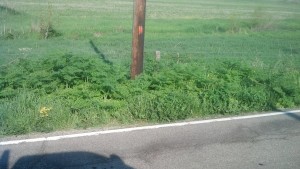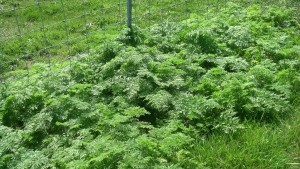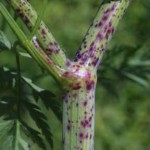– Stan Smith, PA, OSU Extension, Fairfield County
A few weeks ago I posted a piece about identifying and controlling poison hemlock on the Fairfield County Extension Facebook page and the response I got back immediately was simply, “It’s everywhere!” Indeed, in recent years it seems to have become widespread throughout many Ohio counties, Fairfield included. Perhaps we are seeing it spreading most quickly in road and other right-of-ways that are difficult to mow and seldom ever sprayed with a herbicide. From there this noxious weed seems to be spreading into fence rows, barn lots, hay fields and areas of pasture fields that lack enough competition to keep it crowded out. Last week I received a note from a friend in Seneca County explaining he suspects Hemlock poisoning is what recently killed one of his three year old bulls. That said, let’s take a closer look at poison hemlock.
Poison hemlock is a biennial member of the carrot family – Conium maculatum – which can cause respiratory failure and even death when ingested by livestock or humans. It’s a non-native invasive that may, at times, be confused with giant hogweed – Heracleum mantegazzianum – a plant with many similarities and also spreading in parts of Ohio.
In fertile soils poison hemlock may easily grow up to 10 or 12 feet, producing small white flowers that are typical of the carrot family. The plant began flowering around Ohio a few weeks ago. The herb has a smooth, purple-spotted stem; dark, glossy bluish-green fern-like triangular leaves. It has a fleshy white taproot. Both the leaves and roots have a disagreeable parsnip-like odor.
All parts of the plant are poisonous including the leaves, stems, seeds and roots. Simply handling the plant seldom causes a toxic reaction in humans, but ingesting it through the eyes, open wounds, or orally causes poisoning. Perhaps poison hemlock’s most famous claim to fame was when it was used to execute Socrates in 399 B.C.
The taste of the leaves and seeds of poison hemlock is unpleasant to livestock, so toxic quantities are seldom consumed when ample desirable feed is available for the animals. Cattle can usually survive poison hemlock if consumed in amounts less than 0.4% of their body weight (4 to 5 pounds for mature cows) although abortions are possible at lower rates. The toxicity of the plant changes little if fermented with silage or dried in hay.
Being a biennial, poison hemlock is most easily controlled late in the fall after emergence. Crossbow, Banvel and 2,4-D are fairly effective on small poison hemlock even in the spring. Taller plants may need to be controlled with glyphosate. Mowing after the plants have bolted and before seed set will prevent seed production.
